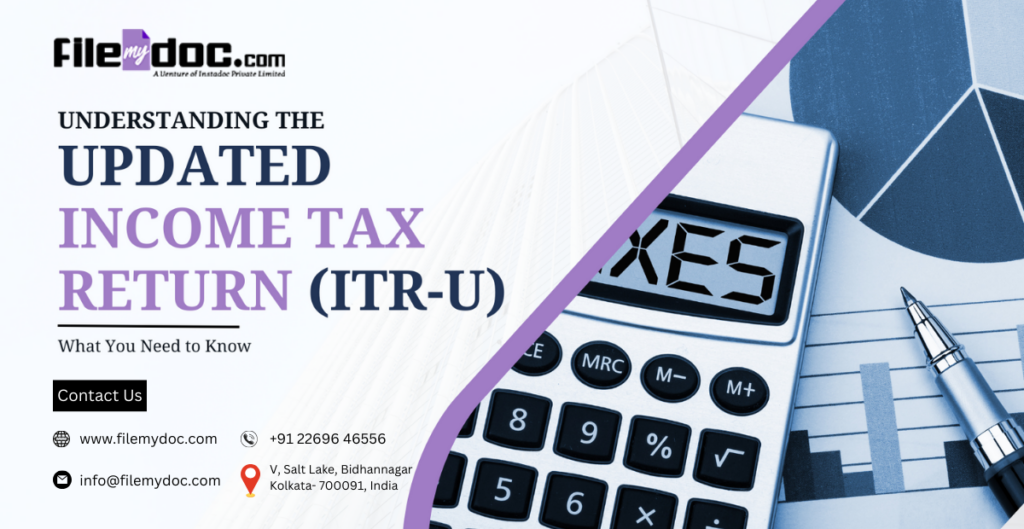Understanding the Updated Income Tax Return (ITR-U): What You Need to Know
Filing income tax returns can be a daunting task, especially when you need to correct an already filed return. To address this, the Indian government introduced the Updated Income Tax Return (ITR-U) form. This article will guide you through the details of ITR-U, its purpose, eligibility criteria, and how to file it.




What is ITR-U?
The ITR-U, or Updated Income Tax Return, is a new form introduced by the Income Tax Department of India. This form allows taxpayers to update their income tax returns even after the original or revised return has been filed. The primary objective of ITR-U is to provide taxpayers an opportunity to correct any errors or omissions in their previously filed returns.
Purpose of ITR-U
- Correction of Errors
ITR-U provides a chance to correct errors made in the original return. This includes mistakes in income reporting, deductions, exemptions, and other financial details. - Avoidance of Penalties
By allowing corrections, ITR-U helps taxpayers avoid penalties for discrepancies in their returns. Timely updates can prevent legal complications and fines. - Increased Compliance
The introduction of ITR-U encourages taxpayers to be more compliant with tax laws by providing a streamlined process for updating returns.
Eligibility Criteria for Filing ITR-U
- Time Frame
Taxpayers can file ITR-U within 24 months from the end of the relevant assessment year. This extended period provides ample time to identify and rectify errors. - Types of Returns
ITR-U can be filed for any type of income tax return, whether it’s ITR-1, ITR-2, ITR-3, or any other form. It is applicable to both individuals and businesses. - Non-Eligibility
ITR-U cannot be used to declare undisclosed income or assets if it’s under scrutiny, reassessment, or appeal. It also cannot be used to reduce the tax liability or claim a refund.
How to File ITR-U
- Access the Form
The ITR-U form is available on the Income Tax Department’s official website. Taxpayers need to download and fill it out accurately. - Enter Corrected Details
Fill in the updated information accurately. This includes corrected income details, deductions, exemptions, and any other relevant financial data. - Calculate Additional Tax Liability
If the corrections result in an increase in taxable income, calculate the additional tax liability. This amount must be paid before submitting the ITR-U form. - Submit the Form Online
Once the form is filled out and the additional tax (if any) is paid, submit the ITR-U form online through the Income Tax Department’s e-filing portal. - Verification
After submission, verify the updated return through the available verification methods such as Aadhaar OTP, net banking, or by sending a signed copy of the ITR-V to the Centralized Processing Center (CPC).
Benefits of Filing ITR-U
- Rectification of Mistakes
Filing ITR-U ensures that any errors in the original return are corrected, leading to accurate tax records. - Compliance with Tax Laws
By updating returns, taxpayers comply with tax laws and avoid legal repercussions. - Peace of Mind
Correcting errors and omissions provides peace of mind, knowing that your tax returns are accurate and complete.
Common Mistakes to Avoid When Filing ITR-U
- Incorrect Information
Ensure all corrected details are accurate. Mistakes in the updated return can lead to further complications. - Missed Deadlines
File the ITR-U within the specified 24-month period to avoid penalties and legal issues. - Incomplete Submission
Double-check that all required fields in the ITR-U form are filled out and that the form is submitted and verified correctly.
Conclusion
The Updated Income Tax Return (ITR-U) is a valuable tool for taxpayers to rectify errors and omissions in their previously filed returns. By understanding the purpose, eligibility, and filing process of ITR-U, taxpayers can ensure compliance with tax laws and avoid potential penalties. Stay informed and proactive in managing your tax returns to maintain accurate and up-to-date financial records.






















